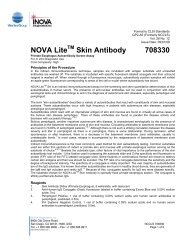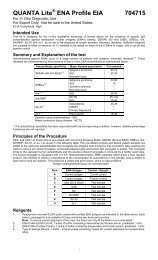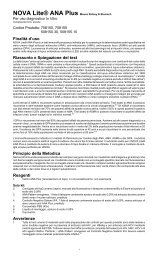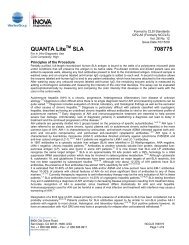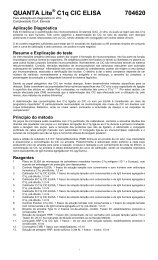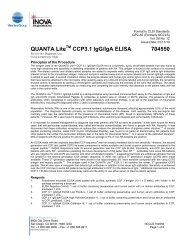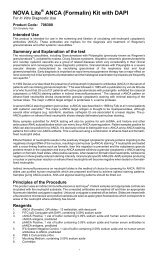Procedure - INOVA Diagnostics
Procedure - INOVA Diagnostics
Procedure - INOVA Diagnostics
Create successful ePaper yourself
Turn your PDF publications into a flip-book with our unique Google optimized e-Paper software.
NOVA Lite dsDNA Crithidia luciliae Kits/Substrate Slides 708200<br />
For In Vitro Diagnostic Use<br />
Product Code: 708200, 708205<br />
508200.10, 508205.20, 508205.80<br />
CLIA Complexity: High<br />
Intended Use<br />
NOVA Lite dsDNA Crithidia luciliae is an indirect immunofluorescent assay for the screening and<br />
semi-quantitative determination of anti-double stranded DNA (dsDNA) in human serum. The<br />
presence of anti-double stranded DNA can be used in conjunction with other serological tests and<br />
clinical findings to aid in the diagnosis of systemic lupus erythematosus (SLE).<br />
Summary and Explanation of the test<br />
The NOVA Lite dsDNA Crithidia luciliae test is an indirect immunofluorescent antibody test<br />
employing the hemoflagellate, Crithidia luciliae, as a substrate. This single-cell organism possesses<br />
a giant mitochondrion containing a highly condensed mass of circular dsDNA. 1 This mass of<br />
dsDNA, known as the kinetoplast, appears to be free of histones or other mammalian nuclear<br />
antigens. 1,2 It serves as a sensitive and specific substrate for detecting autoantibodies to dsDNA.<br />
Autoantibodies to dsDNA occur almost exclusively in patients with systemic lupus erythematosus<br />
(SLE) and as such are considered marker antibodies. Autoantibodies to dsDNA have been included<br />
in the 1982 Revised Criteria for the Classification of Systemic Lupus Erythematosus by an Arthritis<br />
and Rheumatism Association sub-committee. 3<br />
While the commonly used Anti-nuclear Antibody (ANA) test is a sensitive screening test for SLE and<br />
other connective tissue diseases, it is by no means specific for SLE. Because of this, all positive<br />
ANA samples should be tested for specific antibodies to dsDNA. The presence of antibodies to<br />
dsDNA strongly indicates SLE; however, absence of these antibodies does not rule out SLE in all<br />
cases.<br />
A variety of methods have been employed over the years to detect antibodies to dsDNA. These<br />
methods include complement fixation 4 , passive agglutination 5 and RIA. 6-8 The main advantage of a<br />
C. luciliae based dsDNA test is its specificity, due to the nature of the tightly coiled mass of circular<br />
dsDNA in the kinetoplast. 9-11 This characteristic is vitally important for a marker antibody test.<br />
Principles of the <strong>Procedure</strong><br />
In the indirect immunofluorescence technique, samples are incubated with antigen substrate and<br />
unreacted antibodies are washed off. The substrate is incubated with specific fluorescein labeled<br />
conjugate and then unbound reagent is washed off. When viewed through a fluorescence<br />
microscope, autoantibody positive samples will exhibit an apple green fluorescence corresponding<br />
to areas of the cell or nuclei where autoantibody has bound.<br />
Reagents<br />
1. Crithidia luciliae Slides (dsDNA), 6 wells or 12 well/slide, with desiccant<br />
Kits Only<br />
2. Anti-Human IgG Conjugate (Goat) without Evan’s Blue, fluorescein labeled in buffer<br />
containing 0.09% sodium azide<br />
3. dsDNA Positive, 1 vial of buffer containing 0.09% sodium azide and human serum antibodies<br />
to dsDNA, prediluted<br />
4. IFA System Negative Control, 1 vial of buffer containing 0.09% sodium azide and no human<br />
serum antibodies to dsDNA, prediluted<br />
5. PBS Concentrate (40x)<br />
6. Mounting Medium, 0.09% sodium azide<br />
7. Coverslips<br />
Warnings<br />
1. All human source material used in the preparation of controls for this product has been<br />
tested and found negative for antibody to HIV, HBsAg, and HCV by FDA cleared methods.<br />
No test method, however, can offer complete assurance that HIV, HBV, HCV or other<br />
infectious agents are absent. Therefore, the dsDNA Positive and IFA System Negative<br />
Control should be handled in the same manner as potentially infectious material. 12<br />
2. Sodium Azide is used as a preservative. Sodium Azide is a poison and may be toxic if<br />
ingested or absorbed through the skin or eyes. Sodium azide may react with lead or copper<br />
plumbing to form potentially explosive metal azides. Flush sinks, if used for reagent disposal,<br />
with large volumes of water to prevent azide build-up.<br />
1
3. Use appropriate personal protective equipment while working with the reagents provided.<br />
4. Spilled reagents should be cleaned up immediately. Observe all federal, state and local<br />
environmental regulations when disposing of wastes.<br />
Precautions<br />
1. This product (Kit) is for In Vitro Diagnostic Use.<br />
2. Substitution of components other than those provided in this system may lead to inconsistent<br />
results.<br />
3. Incomplete or inefficient washing of IFA wells may cause high background.<br />
4. Adaptation of this assay for use with automated sample processors and other liquid handling<br />
devices, in whole or in part, may yield differences in test results from those obtained using<br />
the manual procedure. It is the responsibility of each laboratory to validate that their<br />
automated procedure yields test results within acceptable limits.<br />
5. A variety of factors influence the assay performance. These include the starting temperature<br />
of the reagents, the strength of the microscope bulb used, the accuracy and reproducibility of<br />
the pipetting technique, the thoroughness of washing and the length of the incubation times<br />
during the assay. Careful attention to consistency is required to obtain accurate and<br />
reproducible results.<br />
6. Strict adherence to the protocol is recommended.<br />
Storage Conditions<br />
1. Store all the slides and kit reagents at 2-8°C. Do not freeze. Reagents are stable until the<br />
expiration date when stored and handled as directed.<br />
2. Diluted PBS buffer is stable for 4 weeks at 2-8°C.<br />
Specimen Collection<br />
This procedure should be performed with a serum specimen. Addition of azide or other<br />
preservatives to the test samples may adversely affect the results. Microbially contaminated, heattreated,<br />
or specimens containing visible particulates should not be used. Grossly hemolyzed or<br />
lipemic serum specimens should be avoided.<br />
Following collection, the serum should be separated from the clot. NCCLS Document H18-A3<br />
recommends the following storage conditions for samples: 1) Store samples at room temperature<br />
no longer than 8 hours. 2) If the assay will not be completed within 8 hours, refrigerate the sample<br />
at 2-8°C. 3) If the assay will not be completed within 48 hours, or for shipment of the sample, freeze<br />
at -20°C or lower. Frozen specimens must be mixed well after thawing and prior to testing.<br />
<strong>Procedure</strong><br />
Materials provided (kits)<br />
708200<br />
10 6-well dsDNA Crithidia luciliae Substrate Slides<br />
1 4mL FITC Anti-Human IgG Conjugate<br />
1 0.5 mL dsDNA Positive<br />
1 0.5mL IFA System Negative Control<br />
1 25mL PBS Concentrate (40x)<br />
1 7mL Mounting Medium<br />
1 10 Coverslips<br />
708205<br />
20 12-well dsDNA Crithidia luciliae Substrate Slides<br />
1 15mL FITC Anti-Human IgG Conjugate<br />
1 0.5 mL dsDNA Positive<br />
1 0.5mL IFA System Negative Control<br />
2 25mL PBS Concentrate (40x)<br />
1 7mL Mounting Medium<br />
1 20 Coverslips<br />
Materials provided (slides)<br />
508200.10 10 x dsDNA Crithidia luciliae Substrate slides (6 well)<br />
508205.20 20 x dsDNA Crithidia luciliae Substrate slides (12 well)<br />
508205.80 80 x dsDNA Crithidia luciliae Substrate slides (12 well)<br />
2
Additional Materials Required But Not Provided<br />
Micropipets to deliver 15-1000μL volume<br />
Distilled or deionized water<br />
Squeeze bottles or Pasteur pipets<br />
Moist chamber<br />
1L container (for diluting PBS)<br />
Coplin jar<br />
Fluorescence microscope with 495nm exciter and 515nm barrier filter<br />
Method<br />
Before you start<br />
1. Bring all reagents and samples to room temperature (20-26 o C) and mix well.<br />
2. Dilute PBS Concentrate: IMPORTANT: Dilute the PBS Concentrate 1:40 by adding the<br />
contents of the PBS Concentrate bottle to 975mL of distilled or deionized water and mix<br />
thoroughly. The PBS buffer is used for diluting patient samples and as a wash buffer. The<br />
diluted buffer can be stored for up to 4 weeks at 2-8°C.<br />
3. Dilute Patient Samples:<br />
a. Initial Screening: Dilute patient samples 1:10 with diluted PBS buffer (i.e., add 100μL<br />
of serum to 900μL of PBS buffer).<br />
b. Titration: Make serial 2-fold dilutions from the initial screening dilution for all positive<br />
samples with diluted PBS buffer (i.e. 1:20, 1:40,... 1:640).<br />
Assay procedure<br />
1. Prepare Substrate Slides: Allow the substrate slide to reach room temperature prior to<br />
removal from its pouch. Label it with pencil and place it in a suitable moist chamber. Add 1<br />
drop (20-25μL) of the undiluted positive and the negative control to wells 1 and 2<br />
respectively. Add 1 drop (20-25μL) of diluted patient sample to the remaining wells.<br />
2. Slide Incubation: Incubate the slide for 30 + 5 minutes in a moist chamber (a dampened<br />
paper towel placed flat on the bottom of a closed plastic or glass container) will maintain the<br />
proper humidity conditions. Do not allow the substrate to dry out during the assay<br />
procedure.<br />
3. Wash Slides: After incubation, use a plastic squeeze bottle or pipet to gently wash off the<br />
serum with diluted PBS buffer. Orient the slide and stream of PBS buffer so as to minimize<br />
wash-over of samples between wells. Avoid directing the stream directly onto the wells<br />
to prevent substrate damage. If desired, place the slides in a Coplin jar of diluted PBS<br />
buffer for up to 5 minutes.<br />
4. Addition of Fluorescent Conjugate: Shake off the excess PBS buffer. Place the slide back<br />
in the moist chamber and immediately cover each well with a drop of fluorescent conjugate.<br />
Incubate the slides for an additional 30 + 5minutes.<br />
5. Wash Slides: Repeat Step 3.<br />
6. Coverslip: Coverslip procedures vary from lab to lab; however, the following procedure is<br />
recommended:<br />
a. Place a coverslip on a paper towel.<br />
b. Apply mounting medium in a continuous line to the bottom edge of the coverslip.<br />
c. Shake off the excess PBS buffer and touch the lower edge of the slide to the edge of<br />
the coverslip. Gently lower the slide onto the coverslip in such a way that the<br />
mounting medium flows to the top edge of the slide without air bubble formation or<br />
entrapment.<br />
Quality Control<br />
dsDNA Positive and IFA System Negative Control should be run on every slide to insure that all<br />
reagents and procedures perform properly. Additional suitable control sera may be prepared by<br />
aliquoting pooled human serum specimens and storing at < -70 o C. In order for the test results to be<br />
considered valid, all of the criteria listed below must be met. If any of these are not met, the test<br />
results should be considered invalid and the assay repeated.<br />
1. The undiluted dsDNA Positive must be > 2+.<br />
2. The IFA System Negative Control must be negative.<br />
3
Interpretation of Results<br />
Negative Reaction. A sample is considered negative if the specific kinetoplast staining is less than<br />
the negative control. Staining of other structures such as the basal body, the flagellum or the<br />
nucleus without concomitant staining of the kinetoplast should be considered negative, for dsDNA<br />
reactivity.<br />
Positive Reaction. A sample is considered positive if specific kinetoplast staining or kinetoplast<br />
plus nuclear staining is observed to be greater than the negative control. All positive samples should<br />
be titered using serial 2-fold dilutions to endpoint.<br />
Determine the fluorescence grade or intensity using these criteria:<br />
4+ Brilliant apple green fluorescence<br />
3+ Bright apple green fluorescence<br />
2+ Clearly distinguishable positive fluorescence<br />
1+ Lowest specific fluorescence that enables the kinetoplast staining to be clearly<br />
differentiated from the background fluorescence<br />
Limitations of the <strong>Procedure</strong><br />
1. The user should be aware of the effects of antibody excess and the possibility of obtaining<br />
non-dsDNA staining patterns while reading the slides.<br />
2. A variety of external factors influence the test sensitivity including the type of fluorescence<br />
microscope used, the bulb strength and age, the magnification used, the filter system and<br />
the observer.<br />
3. If a band pass filter is used instead of a 515 barrier filter, increased artifactual staining may<br />
be observed.<br />
4. Only pencil should be used to label the slides. Use of any other writing material may cause<br />
artifactual staining.<br />
5. All coplin jars used for slide washing should be free from all dye residues. Use of coplin jars<br />
containing dye residue may cause artifactual staining.<br />
6. Results of this assay should be used in conjunction with clinical findings and other<br />
serological tests.<br />
7. The assay performance characteristics have not been established for matrices other than<br />
serum.<br />
Slides sold separately are classified as “Analyte specific reagents”. Except as a component of<br />
NOVA Lite dsDNA Crithidia luciliae Kit, analytical and performance characteristics are not<br />
established.<br />
Expected Values<br />
NOVA Lite dsDNA Crithidia luciliae substrate was used to test a variety of connective tissue<br />
disease patients as well as 200 random blood donors. The results appear below:<br />
Patient Group Number NOVA Lite dsDNA Crithidia luciliae Number Positive<br />
SLE 105 42<br />
Drug Induced Lupus 24 0<br />
Rheumatoid Arthritis 40 0<br />
Scleroderma 24 0<br />
Dermatomyositis 14 0<br />
Sjogren's Syndrome 14 0<br />
Normals 200 0<br />
NOVA Lite is a trademark of <strong>INOVA</strong> <strong>Diagnostics</strong>, Inc.<br />
4
References<br />
1. Aarden LA, de Groot ER, Feltkamp TE: Immunology of DNA. III. Crithidia luciliae, a simple substrate<br />
for the detection of anti-dsDNA with immunofluorescence techniques. Ann. NY Acad. Sci. 254:<br />
505-515, 1975.<br />
2. Crowe W, Kusher I: An immunofluorescent method using Crithidia luciliae to detect antibodies to<br />
double-stranded DNA. Arthritis and Rheumatism 20: 811-814, 1977.<br />
3. Tan EM, et al.: The 1982 Revised Criteria for the Classification of Systemic Lupus Erythematosus.<br />
Arthritis and Rheumatism 25: 1271-1277, 1982.<br />
4. Arana R, Seligmann M: Antibodies to native and denatured deoxyribonucleic acid in systemic lupus<br />
erythematosus. J. Clin. Invest. 46: 1867-1882, 1967.<br />
5. Inami YH, Nakamura RM, Tan EM: Microhemagglutination test for the detection of native and<br />
single-stranded DNA antibodies and circulating DNA antigen. J. Immunol. Methods 3: 287-300, 1973.<br />
6. Aarden LA, Lakmaker F, de Groot ER, et al.: Detection of antibodies to DNA by radioimmunoassay<br />
and immunofluorescence. Scand. J. Rheu. Suppl. 11: 12-19, 1975.<br />
7. Fish F, Ziff M: A sensitive solid phase microradioimmunoassay for anti double-stranded DNA<br />
antibodies. Arthritis and Rheumatism 24: 534-543, 1981.<br />
8. Pincus T, Schur P, Rose JA, et al.: Measurement of serum DNA-binding activity in systemic lupus<br />
erythematosus. The New England J. of Medicine 281: 701-705, 1969.<br />
9. Somerfield SD, Roberts MW, Booth RJ: Double-stranded DNA antibodies: comparison of four<br />
methods of detection. J. Clin. Path. 34: 1032-1035, 1981.<br />
10. Sontheimer RD, Gilliam JD: An immunofluorescence assay for double-stranded DNA antibodies<br />
using the Crithidia luciliae kinetoplast as a double-stranded DNA substrate. J. Lab Clin. Med. 91:<br />
550-558, 1978.<br />
11. Stingl G, Meingassner JG, Swelty P, Knapp W: An immunofluorescence procedure for the<br />
demonstration of antibodies to native, double-stranded DNA and of circulating DNA-anti DNA<br />
complexes. Clin. Immunol. Immunopath. 6: 131-140, 1976.<br />
12. Biosafety in Microbiological and Biomedical Laboratories. Centers for Disease Control/National Institute of<br />
Health, 2007, Fifth Edition<br />
Manufactured By:<br />
<strong>INOVA</strong> <strong>Diagnostics</strong>, Inc.<br />
9900 Old Grove Road<br />
San Diego, CA 92131<br />
United States of America<br />
Technical Service (U.S. & Canada Only) : 877-829-4745<br />
Technical Service (Outside the U.S.) : 00+ 1 858-805-7950<br />
support@inovadx.com<br />
Authorized Representative in the EU:<br />
Medical Technology Promedt Consulting GmbH<br />
Altenhofstrasse 80<br />
D-66386 St. Ingbert, Germany<br />
Tel.: +49-6894-581020<br />
Fax.: +49-6894-581021<br />
www.mt-procons.com<br />
628200ENG September 2010<br />
Revision 15<br />
5




